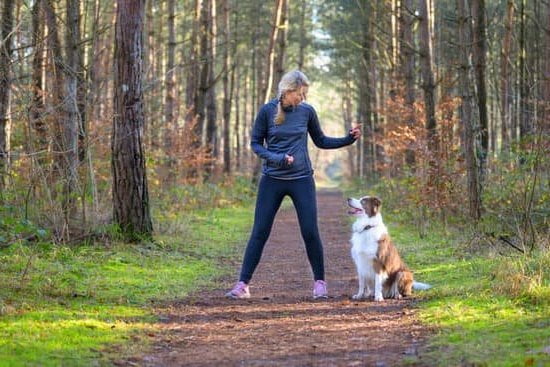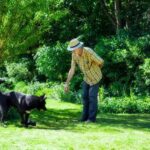Does your old dog constantly pull on the leash during walks, making it a frustrating experience for both you and your furry companion? In this article, we will explore how to train an old dog not to pull on the leash. From understanding the root cause of this behavior to implementing positive reinforcement techniques, we’ll cover everything you need to know to improve your dog’s leash manners.
Older dogs may pull on the leash for various reasons, and it’s essential to understand the underlying causes before addressing the issue. Factors such as age and previous training can significantly impact a dog’s behavior on the leash. By delving into these reasons, you can gain insight into why your old dog pulls and take appropriate steps to remedy this behavior.
Choosing the right equipment is crucial when training an older dog not to pull on the leash. From selecting a suitable collar or harness to exploring anti-pull devices, proper equipment can make a significant difference in managing leash manners. Additionally, establishing a consistent training routine and reinforcing basic obedience commands are key elements in improving your old dog’s leash behavior.
In this section, we will delve deeper into understanding why old dogs pull on the leash and provide insights into how age and previous training may influence their behavior. We will also discuss tips for selecting suitable leashes and collars for older dogs and explain the benefits of using harnesses and anti-pull devices during walks.
By gaining a comprehensive understanding of these factors, you’ll be better equipped to train your old dog not to pull on the leash effectively.
The Importance of Proper Equipment
As dogs age, it’s essential to make sure they have the right equipment for leash training. Older dogs may have different needs when it comes to leashes and collars, so selecting the proper gear is crucial for their comfort and safety.
Tips for Selecting a Suitable Leash and Collar for an Older Dog
When choosing a leash for an older dog, consider one that provides more control and distributes pressure evenly. A shorter leash can help maintain better control, while a longer leash may lead to tangling or pulling. Additionally, collars with padding or wider bands can be gentler on an older dog’s neck, especially if they tend to pull during walks.
Explaining the Benefits of Harnesses and Anti-Pull Devices
For older dogs who struggle with pulling on the leash, harnesses can be a great option. They distribute pressure more evenly across the body and discourage pulling behavior.
Anti-pull devices such as head halters or no-pull harnesses can also offer additional support in reducing leash pulling, providing a more comfortable experience for both the dog and the owner. It’s important to consult with a veterinarian or professional trainer before using anti-pull devices to ensure they’re appropriate for your dog’s specific needs.
Ultimately, choosing the right leash and collar for an older dog comes down to prioritizing their comfort and safety. By considering their unique needs and potential challenges related to age, owners can make walking a more enjoyable experience for their senior canine companions.
Patience and Consistency
Establishing a consistent training routine is crucial when it comes to teaching an old dog not to pull on the leash. Older dogs may have developed habits over the years, and breaking those habits will take time and dedication. Patience and consistency are key components in successfully training an older dog to walk calmly on a leash.
Implementing a Consistent Training Schedule
To establish a training routine, it’s important to set aside regular times for leash manners training. This can include daily walks or dedicated training sessions at home or in a controlled environment. By incorporating regular practice into the dog’s schedule, they will begin to understand that walking on a leash calmly is an expected behavior.
It’s also essential to be consistent with the commands and techniques used during training. Using the same cues, body language, and rewards each time will help reinforce the desired behavior. Changing methods or expectations can confuse an older dog and make it more difficult for them to learn.
Emphasizing the Importance of Patience and Positive Reinforcement
Older dogs may take longer to learn new behaviors, so patience is crucial during the training process. It’s important not to rush or become frustrated if progress is slow. Instead, focus on small victories and progress, offering plenty of praise and encouragement.
Positive reinforcement is another key aspect of establishing a training routine. Rewarding good behavior with treats, praise, or favorite toys will motivate the older dog to continue exhibiting calm leash manners. Consistently using positive reinforcement helps create a positive association with walking on a leash without pulling.
Basic Obedience Training
Older dogs may have developed habits of pulling on the leash over time, but reinforcing basic obedience commands can help improve their leash behavior. Teaching your older dog to follow commands such as “heel” and “stay” can make walks more enjoyable for both you and your furry companion. Here are some tips for integrating obedience training into leash training:
1. Review Basic Commands: Before starting leash training, it’s important to review and reinforce basic commands with your older dog. Practice “sit,” “stay,” and “heel” in a controlled indoor environment where there are minimal distractions.
2. Integrate Commands During Walks: Once your older dog is comfortable responding to basic commands in a controlled setting, begin integrating these commands during walks. Use the “heel” command to encourage your dog to walk calmly beside you without pulling on the leash.
3. Use Positive Reinforcement: When your older dog successfully follows a command during a walk, be sure to offer plenty of praise and even a tasty treat as a reward. Positive reinforcement can help reinforce good behavior and encourage your dog to continue obeying commands while on the leash.
By reinforcing basic obedience commands, you can help improve your older dog’s leash behavior and make walks together more enjoyable. Consistency and patience are key when integrating obedience training into leash training, so be sure to practice regularly and reward good behavior throughout the process.
Taking Small Steps
When training an old dog not to pull on the leash, it is essential to begin the process slowly and gradually introduce distractions. Older dogs may have ingrained habits and behaviors that are challenging to change, so patience is key when trying to modify their leash behavior.
To effectively introduce distractions during leash training, consider the following approaches:
- Start in a familiar, low-distraction environment: Begin the training process in a familiar and comfortable setting for your older dog, such as your backyard or a quiet street with minimal activity. This will allow them to focus on learning without being overwhelmed by external stimuli.
- Increase difficulty over time: Once your dog has mastered walking calmly on the leash in low-distraction environments, gradually expose them to more challenging situations. This could include walks in busier areas, encounters with other dogs or people, and exposure to different sounds and smells.
- Use positive reinforcement: Whenever your old dog successfully maintains good leash behavior despite distractions, be sure to reward them with treats, praise, or any form of positive reinforcement they respond well to. This will help them associate staying calm with pleasant experiences.
By taking small steps and gradually introducing distractions into your older dog’s leash training routine, you can help them develop better walking habits over time while minimizing stress and frustration for both you and your canine companion.
Positive Reinforcement Techniques
Understanding the importance of positive reinforcement techniques is essential when training an old dog not to pull on the leash. Rewarding good leash behavior can significantly improve a dog’s behavior and make walking a more enjoyable experience for both the pet and the owner. Effective methods for reinforcing desired behavior include the use of treats, praise, and clicker training.
When implementing positive reinforcement, it is crucial to find the right type of reward that motivates the older dog. For some dogs, small food treats work best as a form of positive reinforcement. It’s essential to choose treats that are not only appealing but also healthy for your pet.
Other dogs may respond well to verbal praise and affection from their owners. Positive words such as “good boy” or “good girl” can go a long way in encouraging them to exhibit good leash manners.
Clicker training is another effective method for positively reinforcing good leash behavior in older dogs. This technique involves using a small handheld noisemaker called a clicker to create a sound associated with positive behavior. When the dog behaves well on the leash, the owner can click the device and follow it with a treat or praise. Over time, the dog learns to associate the clicking sound with doing something right while on the leash.
Implementing positive reinforcement techniques requires consistency and patience. It’s important to reward good leash behavior immediately so that the dog understands what they are being rewarded for. With time and practice, an older dog can learn to exhibit good leash manners through positive reinforcement.
| Positive Reinforcement Techniques | Rewarding Good Leash Behavior |
|---|---|
| Methods | Treats, praise, clicker training |
| Rewards | Food treats or verbal praise and affection |
| Consistency and Patience | Importance of immediate rewards and practice |
Redirecting Unwanted Behavior
When it comes to managing pulling and lunging behavior in older dogs, it’s important to employ effective techniques that can redirect their attention and behavior. One method is to use positive reinforcement, rewarding and reinforcing good leash behavior. This can include using treats, praise, or clicker training to encourage the dog to focus on walking calmly beside you.
Another useful strategy for managing unwanted behaviors like pulling and lunging is to desensitize the older dog to triggers that cause them to act out on the leash. This involves gradually introducing distractions during walks, starting with less challenging stimuli and gradually working up to more intense ones. By exposing the dog to these triggers in a controlled manner, they can learn to remain calm and focused.
In some cases, it may be necessary to seek professional help from a trainer or behaviorist who has experience working with older dogs exhibiting leash-related issues. A reputable trainer can assess the root causes of the dog’s behavior and provide tailored guidance on how to effectively redirect unwanted behaviors. Additionally, they can work with owners to develop a personalized training plan that takes into account the unique needs of older dogs.
| Technique | Summary |
|---|---|
| Positive Reinforcement | Includes using treats, praise or clicker training |
| Desensitization | Gradually introducing distractions during walks |
| Professional Help | Evaluating potential causes of unwanted behaviors and providing personalized guidance |
Seeking Professional Help
As much as you may try to train your old dog not to pull on the leash by yourself, there may come a point where seeking professional help becomes necessary. Professional trainers have the expertise and experience to address specific behavioral issues in older dogs, including leash pulling. If you are facing persistent challenges despite your best efforts, it may be time to consider hiring a professional trainer.
One of the signs that it’s time to seek professional help is if your dog’s leash pulling is causing safety concerns for either you or your pet. A professional trainer can provide guidance on managing and correcting this behavior effectively. Additionally, if previous training methods have not yielded positive results, a professional trainer can offer alternative techniques tailored to your old dog’s specific needs.
When choosing a professional trainer for your older dog, it’s important to do thorough research and select someone with a proven track record in addressing leash behavior issues in senior dogs. Look for credentials, such as certification from recognized organizations, and consider seeking recommendations from other pet owners or veterinary professionals.
With the right professional assistance, you can work towards improving your old dog’s leash manners and creating a safer and more enjoyable walking experience for both of you. Remember that seeking help is not an admission of failure but rather a proactive step towards finding effective solutions for your pet’s behavioral challenges.
Frequently Asked Questions
What Is the #1 Trick to Stop Your Dog Pulling on the Leash?
The #1 trick to stop your dog from pulling on the leash is to use positive reinforcement training. This means rewarding your dog for walking nicely by your side and teaching them that pulling will not get them what they want. Consistency, patience, and plenty of treats are key to successfully teaching your dog to walk without pulling.
How Do I Get My 3 Year Old Dog to Stop Pulling His Leash Tips?
Getting a 3-year-old dog to stop pulling on his leash requires consistent training and patience. Using positive reinforcement techniques, such as rewarding good behavior with treats or praise, can help teach your dog to walk calmly beside you.
It’s important to be patient as breaking this habit may take some time, especially if the behavior has been reinforced over a long period of time.
How Long Does It Take to Train a Dog to Stop Pulling on Leash?
The time it takes to train a dog to stop pulling on the leash can vary depending on the individual dog and their previous habits. Some dogs may grasp the concept fairly quickly, while others may take longer to learn and become consistent with their good behavior.
With dedicated training sessions, consistency, and positive reinforcement, many dogs can learn to walk without pulling within a few weeks or months.

Welcome to the blog! I am a professional dog trainer and have been working with dogs for many years. In this blog, I will be discussing various topics related to dog training, including tips, tricks, and advice. I hope you find this information helpful and informative. Thanks for reading!





